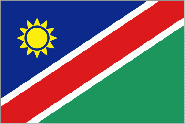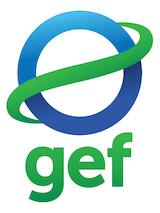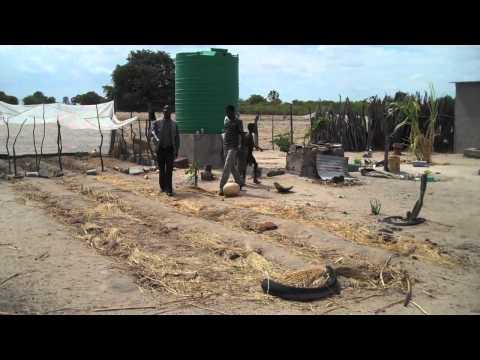CBA Namibia: Harnessing Coping Strategies Via a Holistic Approach for Community Adaptation to Climate Change (CES)
One of the largest countries in sub-Saharan Africa, Namibia is also the driest. With an estimated population of about two million people, Namibia has the world's second lowest population density. In Omusati, Ohangwena, Oshikoto, Oshana and Kavango regions, the majority of the community members are subsistence farmers. Climate change negatively affects food and water security, jeopardizing the livelihoods of these communities.
This Community-Based Adaptation project pilots the implementation of six coping strategies to climate change vulnerability that can be duplicated on a large scale in other similar communities. With the support of project partners such as Creative Entrepreneurs Solutions (CES), the project was prepared and is being implemented through a participatory process involving different sectors of the communities. Project activities based on the six coping strategies help the communities to sustain food security and income generation with no adverse impacts to the land or other natural resources.
* This project is part of Namibia's Community-Based Adaptation portfolio. *
Project details
Levels of intervention
- Community
Source of funds
- Global Environment Facility - Strategic Priority on Adaptation
Key implementers
- Non-Governmental Organizations
Funding amounts
Project partners
- Creative Entrepreneurs Solutions (CES)
- United Nations Development Programme (UNDP)
- Global Environment Facility (GEF)
- The GEF Small Grants Programme
- UN Volunteers
Introduction
One of the largest countries in sub-Saharan Africa, Namibia is also the driest. With an estimated population of about two million people, Namibia has the world's second lowest population density. In Omusati, Ohangwena, Oshikoto, Oshana and Kavango regions, the majority of the community members are subsistence farmers. Climate change negatively affects food and water security, jeopardizing the livelihoods of these communities.
This Community-Based Adaptation project pilots the implementation of six coping strategies to climate change vulnerability that can be duplicated on a large scale in other similar communities. With the support of project partners such as Creative Entrepreneurs Solutions (CES), the project was prepared and is being implemented through a participatory process involving different sectors of the communities. Project activities based on the six coping strategies help the communities to sustain food security and income generation with no adverse impacts to the land or other natural resources.
* This project is part of Namibia's Community-Based Adaptation portfolio. *





Project details
As global climate change impacts become more eminent, one of the worst affected areas is Namibia. Yields for Namibia's small scale farmers are arguably the lowest in the world, a fact attributed to the country's dry climate and poor soils. In the communities of the Omusati, Ohangwena, Oshikoto, Oshana and Kavango regions, the majority of the community members are subsistence farmers who depend highly on rainfed dry land crops and livestock rearing for both subsistence and income. Climate change poses significant challenges to the poor and marginalized communities of these areas as it negatively affects food and water security, which in turn, jeopardizes their livelihoods.
This Community-Based Adaptation project uses six local interlinked climate change coping strategies to create a holistic approach to community-based adaptation. Most concepts are integrated and piloted in all the project sites, while some remain site-specific. Strategies include awareness-building interventions on climate change, coping strategies and nutritional needs, as well as social mobilization of community members into Self Help Groups (SHG). SHGs are created as a means of taking charge of their own development, savings and lending. Other strategies include ensuring water and food security through flood and rain harvesting for agricultural irrigation, livestock, and fish farming. Irrigated vegetable production using harvested flood and rain water supports HIV/AIDS affected families.
Additionally, dry land crop production is improved through composting, biochar, crop rotation, and conservation agriculture. Increased usage of improved drought resistant pearl millet varieties (the national staple food called “Mahangu”), rice, mushroom, and sweet stem are used for human nutrition as well as fodder security to boost availability of protein nutrition and incomes. Lastly, the use of energy efficient stoves and agroforestry combined with general reforestation techniques help sustain food security and income generation with no adverse impacts to the land and other natural resources.
This Community-Based Adaptation project is delivered through the Small Grants Programme (SGP), allowing for a fast, flexible and proven mechanism to reach communities and civil society at the local level. In addition, a UN Volunteer partners with UNDP and SGP to enhance community mobilization, recognize volunteers’ contribution and ensure inclusive participation around the project, as well as to facilitate capacity building of partner NGOs and CBOs.
Members of participating communities have played important roles during the formulation of the project. Women and young people, in particular, have committed to volunteer their time, labour, materials, and knowledge during its implementation. The project’s longevity will be ensured through training and awareness-raising programs that increase residents’ skills and knowledge in sustainable water harvesting, food and fodder security, agro-forestry and reforestation techniques, nutrition and entrepreneurship.
Other partners include Green Life Trust, Ministry of Agriculture, Water, and Forestry, Agronomic Board, Royal Institute of Technology (Sweden). The Government of Japan has contributed to this CBA project, as well as to other CBA projects in Namibia and Niger. The activities supported by these funds include soil conservation, water harvesting, and development of the country-level CBA portfolio, including capacity-building for prospective NGOs. It is foreseen that these activities will contribute to the gathering and leveraging of lessons for effective policy impact at national levels.
- Community
- Non-Governmental Organizations
Subsistence Farmers
- Creative Entrepreneurs Solutions (CES)
- United Nations Development Programme (UNDP)
- Global Environment Facility (GEF)
- The GEF Small Grants Programme
- UN Volunteers
News
Key results and output
Objective 1: Water harvesting of flood and rain water for water security.
Restore traditional water wells (rain as well as flood fed) and also introduce underground water harvesting tanks in the traditional water ways as done traditionally in the desert areas of North West India.
Objectives 2 and 3: Agriculture/sustainable land management addressing land degradation for food security.
Install irrigation for vegetable production from harvested rain and flood water, and pilot dry land crops. Increase soil fertility and soil water holding capacity through use of natural fertilizer (organic material in the form of compost, bio char and fertilizer trees). Test large scale composting together with the Green Scheme and small scale farmers so as to ensure that green matter is not wasted in existing vegetable and larger scale farming operations.
Objective 4: Flood and drought resistant crops
Locally produce of oyster mushrooms (a rich protein source), rice (to be grown in flooded areas and natural oshanas) and sweet stem sorghum for human nutrition sources as well as fodder security for livestock/chicken/fish. Gains from sweet stem sorghum are multiple: Grain, sugar, stems and leaves that could be stored as silage for livestock fodder in the dry season/droughts, used as compost materials or material for bio-gas digesters. The increased use of improved drought resistant mahangu varieties will ensure staple food security in changing climates.
Objective 5: Energy efficient wood stoves and renewable energy in combination with agro forestry/general reforestation and improved natural resource management.
Introduce energy efficient stoves that reduce up to 75% usage of fire wood for cooking food, in combination with agroforestry (i.e. the farming and intercropping of fire wood trees, fruit trees, indigenous trees and bushes, and fertilizer trees). Establish community leadership of local plant nurseries to ensure the availability of large amounts of tree seedlings. Pilot local bio-gas production through green stoves from sweet stem sorghum. Install solar power at all sources needing electric power, such as irrigation pumps.
Objective 6: Awareness building interventions on climate change, coping strategies, global warming and nutrition.
Awareness raising (CBA toolkit) and community members engaged in raising programme focusing on climate change risks and adaptation strategies. CBOs, NGOs, businesses, tradtional and local authrorities participation alongside communities through the local development committees. Exchange of experiences and coping strategies between regions. Exposure trips to each other by communities participating in implementing the six proposed concepts Nutrition and food production awareness raising (with focus on child nutrition, nutrition for people living with HIV/AIDS).
Reports & publications
Videos & multimedia
Monitoring & evaluation
Monitoring and evaluation for community-based adaptation is a new field, and the CBA project is piloting innovative approaches to evaluating the success of locally-driven adaptation projects, and generating lessons to inform ongoing practice.
Key considerations in M&E for CBA include:
- Grounding M&E in the local context: M&E for CBA should avoid overly rigid frameworks, recognizing community heterogeneity and maintaining local relevance
- Capturing global lessons from local projects: CBA projects are highly contextualized, but lessons generated should be relevant to stakeholders globally
- Incorporation of both quantitative and qualitative indicators: to ground projects in tangible changes that can be objectively evaluated, and to capture lessons and case studies for global dissemination
To these ends, the CBA project uses three indicator systems: the Vulnerability Reduction Assessment, the Small Grants Programme Impact Assessment System, and the UNDP Climate Change Adaptation Indicator Framework.
The Vulnerability Reduction Assessment (VRA)
The VRA is a question-based approach with the following aims:
- To make M&E responsive to community priorities
- To use M&E to make projects more accountable to local priorities
- To make M&E capture community ideas and local knowledge
- To gather community-level feedback to guide ongoing project management
- To generate qualitative information
- To capture lessons on specific issues within community-based adaptation
- To generate case studies highlighting adaptation projects
The VRA follows UNDP's Adaptation Policy Framework, and is measured in a series of meetings with local community stakeholders. In these meetings, locally-tailored questions based on standard VRA questions/indicators are posed, and the community assigns a numerical score on a 1-10 scale for each question. Progress is evaluated through changes in scores over the course of implementation, as well as through qualitative data collected in community discussions surrounding the exercise.
UNDP has developed a Users Guide to the VRA (Espanol) (Francais) as a tool to assist practitioners to conceptualize and execute VRA measurements in the context of CBA projects.
The SGP Impact Assessment System (IAS)
The CBA, being a project of the GEF Strategic Priority on Adaptation, aims to increase the resilience of ecosystems and communities to the impacts of climate change, generating global environmental benefits, and increasing their resilience in the face of climate change impacts. To this end, the CBA projects use the SGP's impact assessment system for monitoring achievements in GEF focal areas (focusing primarily on biodiversity and sustainable land management).
The IAS is composed of a number of quantitative indicators which track biophysical ecosystem indicators, as well as policy impact, capacity development and awareness-building.
UNDP Climate Change Adaptation Indicator Framework
CBA projects also track quantitative indicators from UNDP's adaptation indicator framework, corresponding to the thematic area on natural resources management. More information on UNDP's indicator framework can be found on the UNDP climate change adaptation monitoring and evaluation website.
* This description applies to all projects implemented through UNDP's Community-Based Adaptation programme. Specific details on this project's M&E will be included here as they become available. *
Newsfeed
Contacts
- UNDPCharles Nyandiga
- GEF Small Grants ProgrammeNickey GassebSGP National Coordinator
- UNDPCBA Project Management Unit

